Have you ever thought of talking cats? Yes — cats that can talk. Some of the breeds of cats will imitate human sounds. So you come into an unexpected world. This paper discusses the breeds of talking cats: breeds that imitate the sounds of humans and how-they-do it. And we shall plunge deep into the meaning of what cats that can talk really say. We are going to tell you why this is the case. We will also enumerate certain breeds. You will hear about the talking cats, the way they imitate sounds of people, and the breeds that are mostly mentioned. Be ready to receive unbelievable facts concerning cats: those breeds that imitate human sounds.
What Does Cats that can talk mean?
Cats That Can Talk, we do not refer to talking cats as using full sentences of human speech (at least not scientifically proved). We refer here to those cats that utter sounds that sound like human utterances or imitate human utterances. It is widely observed by pet owners: they say their cat is talking to them, or imitating a human voice.
According to behavior science , Some of the cats can be trained to produce a me0w that resembles the sound of a baby crying or even in a human tone (felixcatinsurance.com).
A recent article says Kinship, “There is a great probability that the videos are not original or were edited and such utterances might be entirely random”
So when we tell about Cats That Can Talk we actually mean talking cats that apes sound like humans or makes sounds that are similar to those of humans.
Cats That Can Talk: Why Some Cats Mimic Human Sounds

1. Vocal learning and mimicry
Cats are not deprived of the vocal apparatus to make numerous sounds. Cats that are subjected to human speech repeatedly may select intonations. For example, one blog states:
Learning and Yearning writes, When your cat hears you call them with hello too many times, they might learn the sound and also they will imitate it.
Therefore, the environment is important. Focusing more on human speech can also result in imitation.
2. Bond with the owner
The presence of cats that imitate human noises can be attributed to the fact that there is a relationship between the cats and their humans. As one reddit poster wrote:
Cats will imitate the speech of their owners to be able to communicate with them. They are able to obtain the irritants of speech patterns. And in such houses where the human is used to talk aloud, the cat might attempt to answer it in its manner.
3. Reinforcement or attention-seeking.
When a cat does something that sounds like it was a human speech and the owner responds (laughs, gives food, pets the cat) the cat may do it again. Therefore, learned behavior can still be disguised as mimicry.
4. Human interpretation / phonic illusion
It is not always that we can assume that it is human-like speech. The article notes:
As soon as you had that which you were seeking, it became all quite clearer… It is until, however, you read the lyrics and all of it makes sense. Part of the effect might then be us hearing what we would like to hear.
5. Differences in vocalization in breeds.
Wikipedia says, There are breeds of cats which are more talkative by nature. The louder the breed the greater the chances that you would see talking cats. One such example is the breed of Japanese Bobtail which is said to be abnormally talkative.
- Indications to Monitor That Your Cat is Mimicking Human Noises.
- When you think that you have one of the cats that can talk, watch, watch:
- The cat has a human-like intonation (rising/falling tones) in the form of a meow or sound.
- When you say a particular word or sound the sound repeats itself.
- When making the sound (looking at you), the cat alters his/her posture and attention.
- You hear other strange sounds other than the ordinary meows and chirps or purrs.
- The cat appears to me to answer (in a manner), as you talk.
Naturally, such a cat does not mean complete sentences of humans. But you can hear funny and unexpected sounds of hello, mom, or what.
Clues to Notice When Your Cat Is Mimicking the Humans
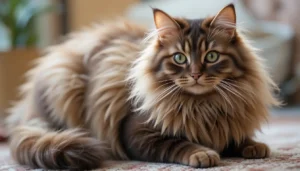
- You think you had one of the talking cats, watch about them:
- The cat has a human-like intonation (rising/falling tones) meow or sound.
- When you repeat a certain word or sound, you can hear the sound repeatedly.
- When making the sound (looking at you), there is a change in the cat in posture and attention.
- You hear other different kinds of calls besides the common meows, chirps or purrs.
- The cat appears to react (in its own way) to the words you say.
Naturally, such a cat does not necessarily mean complete human sentences. However, you can receive entertaining, unexpected, hello, mom, what and so on.
Top 6 Breeds Known for Vocality & Potential for Mimicry
These are the six breeds that will be memorable due to their talkative behaviors and, therefore, the possibility to join the list of cats that can talk: breeds that mimic human sounds story.
1. Siamese cat
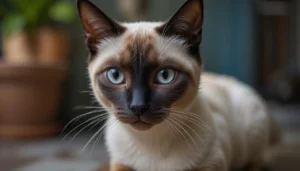
Briar Patch Veterinary Hospital says, It is a vocal breed that is very popular. On one blog of the vet hospital, it describes the silamese cat as: “Do you want a social and talkative cat, the Siamese cat is the one you want.”
Their preference as a pet stems largely out of their mewing behavior, and their strong connection with humans and thus they are also one of the best pets to seek as far as cats that speak are concerned. You can not have an ideal human voice, but you will have a highly expressive cat.
2. Japanese Bobtail
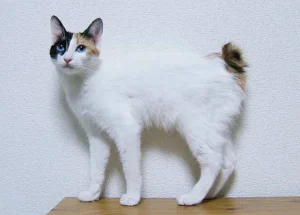
Wikipedia observes, As it has been mentioned, this breed is characterized by the fact that it is regarded as an abnormally talkative breed because of its “soft voices with the ability to produce almost a whole scale of tones as well.
Therefore, the Japanese Bobtail has been mentioned among those cats who can learn to talk as it is said that it is quite flexible in its speech and can be a mimic.
3. Balinese cat

According to The Spruce Pets, this is a long-hired relative of the Siamese which is described as being very vocal, and very demanding, they also like talking to their humans.
Their vocal nature of chatterboxes is intriguing in the face of talking cats.
4. Oriental Longhair

The Spruce Pets defines, According to the breed overview, these cats are talkative and like to communicate with people.
The connection to the Siamese origin and the strong communicative necessity implies that they can descend into the group of cats that can speak.
5. Sphynx cat
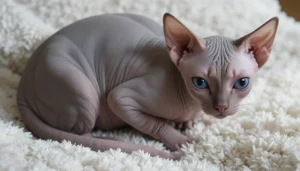
Kinship analyzes, Cats that fall in the category of cats that can talk are not all purebred. There are domestic cats that are exposed to human speech and those who are owned in interactive homes and display remarkable mimicry. An example is an article which monitors random speech emulations in cats that were exposed to human speech.
It is therefore worth noting the presence of non-pedigree cats in this tale.
Cats That Can Talk: Surprising Real-Life Examples
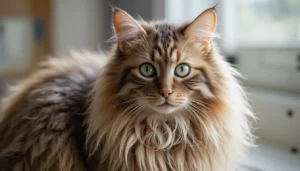
These are some of the real life notes which will shock you.
According to the owners of Reddit forums:
- “Years ago had a cat that could make vocalizations that were somewhat like English words, such as when one or two words in succession.”
Yes, people think so, their cats make up human sounds.
In one of the articles felixcatinsurance.com, it is mentioned that a cat meow is not merely meow:
- Others can even get to the level of meowing in a way that is so much like baby crying or even aping human intonations.
A very bold thing to say about talking cats.
On the contrary: Skeptical review:
- “With enough cats you can get a couple of them to make the noise they make now and then that sounds like human speech.” (Kinship)
- This warning shows the rarity and the unpredictability of the phenomenon.
Yes, the subject of talking cats: the breeds which imitate human noises is not a myth – with conditions.
Why It is Rare -And Why It Shall Matter
Rare
- The majority of cats do not utter definite human-words.
- The reinforcement and environment should agree.
- Certain utterances can be misunderstood.
- It is not scientifically solid, but anecdotal.
Matters
To the owners: it is such a magical experience to hear your cat make human-like sounds and this strengthens the connection.
To the researchers: these cases demonstrate the flexibility of the vocalization of cats and the communication between humans and animals.
Care Tips If You Think Your Cat is “Talking”

Cats That Can Talk, unless you are in the position of having a cat who appears to be one of those so-called cats that can talk, here are some suggestions you can use to help your special cat:
- Act in a positive way: When your cat purrs like a human being, then react by responding lightly. They feel safe to talk with the help of reinforcement.
- Record and observe: You can record the sound using your phone. Record the time of it (e.g. you say hello and the cat replies).
- Promote communication: Speak with your cat much. Use varied intonations. They may pick up more.
- Enrichment: A curious cat would tend to talk more. Toys, human contact and environmental diversity are stimulating.
- Health check: At times the variation of the voice may be the sign of health complications. In case the sound seems strange or it is accompanied with distress, contact a vet.
- Adhere to the natural boundaries: Do not forget that your cat is never going to say a complete human sentence. Take the imitation as a sportsmanlike thing.
to be concluded, cats that can speak have a meaning in the sense of mimicry. They do sound like humans. Certain breeds are more probable to make it to the club of Cats That Can Talk due to being naturally vocal, as well as due to their environment. The astonishing impact is that what appears to be talking can be just a trained mimicry or translation done by humans but it nevertheless forms an intriguing bond.
When you need to find a feline friend, and you want something special one of the Cats That Can Talk, adopt a breed with a reputation of being vocal, spend a lot of time with your cat, and provide a rich interactive atmosphere. Expect surprises. Anticipate there are times you will hear something that puts a smile on your face either, say, hello. And keep in mind: you can be included in a very exclusive group of human beings who think that their cat speaks.
There you have it, the complete, in-depth guide on cats that can talk – by breeds that mimic human sounds, it is full of insights, tips and even more surprising facts. I wish it may assist you in comprehending this wizardly phenomenon -and may also make your own cat speak words you will smile at.
Frequently Asked Questions:
1. Can cats really talk like humans?
Not exactly. Cats that can talk don’t form real words or sentences like humans, but some breeds can mimic human sounds or intonations that sound like words such as “hello” or “no.” It’s a fascinating form of vocal mimicry, not real language.
2. Which cat breeds are known as cats that can talk?
Some of the most talkative breeds include the Siamese, Japanese Bobtail, Balinese, Oriental Longhair, and Sphynx. These cats naturally have strong vocal personalities, making them more likely to mimic human-like sounds.
3. Why do cats try to mimic human voices?
Cats that can talk often do so because they hear human voices daily. Over time, they may imitate tones and pitches to grab your attention or to communicate better. It’s usually a mix of curiosity and learned behavior.
4. Are cats that can talk trying to communicate with their owners?
Yes, in their own way. When cats that can talk mimic human sounds, they’re trying to communicate — often seeking food, attention, or affection. It’s their version of joining the conversation!
5. Can all cats learn to mimic human sounds?
Not all cats can talk or mimic human voices. It depends on the cat’s breed, environment, and personality. Highly social and vocal breeds are more likely to exhibit this behavior.
6. How can I encourage my cat to mimic human sounds?
Talk to your cat often, repeat simple words like “hello” or their name, and reward them when they respond vocally. Cats that can talk thrive on positive reinforcement and frequent human interaction.
7. Is it normal if my cat suddenly starts making human-like sounds?
If your cat suddenly sounds like they’re talking, it’s usually harmless and may simply be a new vocal habit. However, if it’s accompanied by signs of distress, see a vet to rule out any throat or respiratory issues.
8. What makes Siamese cats so talkative?
Siamese cats have a genetic tendency for vocal expression. Their loud, expressive meows and strong bond with humans make them stand out as one of the most well-known cats that can talk.
9. Can kittens also mimic human sounds?
Yes! Some kittens start developing vocal patterns early. If raised in a talkative home, a kitten may grow up to be one of those rare cats that can talk — especially if encouraged gently.
10. Are there viral videos of cats that can talk?
Absolutely! Online platforms like YouTube and TikTok feature many clips of cats that can talk, mimicking words like “mama,” “hello,” or “I love you.” While not every video is genuine, many are real examples of mimicry in action.







